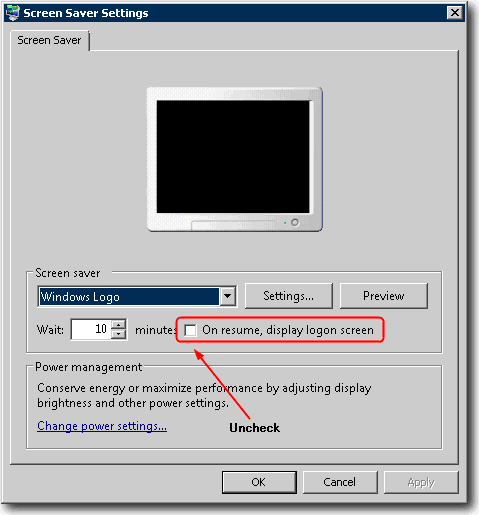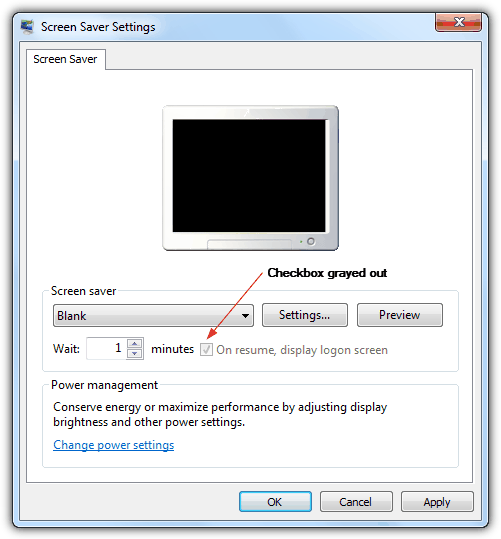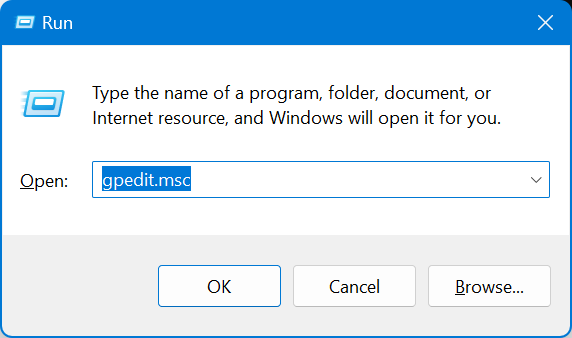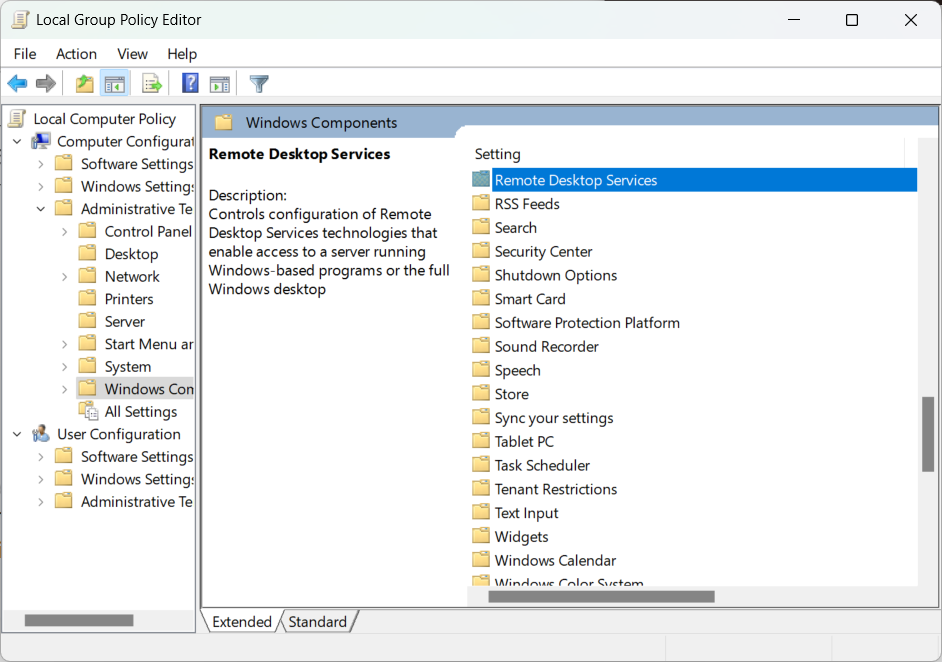How to Disable Remote Desktop from Locking Screen
I’ve never had issues with Remote Desktop, except for one annoyance: after a few minutes of idle time, it auto logs off and requires me to re-enter the password. This is frustrating when reviewing log files or console messages. The solution to disabling the idle logoff is simple, though.
Initially, I misunderstood the issue, thinking the system was logging out when idle. It turned out the screen was locking instead. The “Never” setting for idle session limit in RDP Properties didn’t work because of this.
By default, Windows Server activates the screen saver after 10 minutes of inactivity, and the “On resume, display logon screen” setting is enabled. When this happens, the screen saver is removed upon returning to the Remote Desktop, prompting a login. To fix this, you can either disable the screen saver or remove the logon screen on resume.
How to disable remote desktop automatic screen lock
Try a modified registry file
To disable the auto lock screen when idle, the easiest solution which requires only a click is to download this registry fix file, run it on the computer that is automatically getting locked and restart the PC for the changes to take effect. Alternatively, here are the steps if you prefer to do it manually.
- Right-click Desktop and select Personalize
- Click Screen Saver
- Uncheck “On Resume, display logon screen” and click OK.

Now you can remain idle on the remote desktop connection as long as you want and you won’t be locked out. And obviously this also works on an ordinary PC if you keep receiving the login screen whenever you come out from a screensaver.
What If the Setting Is Grayed Out?
If the “On Resume, display logon screen” option is disabled or grayed out, it likely means a group policy is preventing you from modifying the setting. This might be enforced by your company’s network administrator. Fortunately, you can easily bypass this policy.
- Download Reg Fix to Delete the Password Protect Screen Saver Group Policy: This will delete the group policy and allow you to manually enable or disable the screen saver settings.
- Download Reg Fix to Disable Password Protect Screen Saver Group Policy: This will allow you to disable the screen saver while keeping the setting locked.
These registry fixes are quick and efficient ways to regain control over the screen saver settings, even if you don’t have administrator privileges.

Using Group Policy for Fine-Tuned Control
If you’re working on a Windows Server or have administrative rights, you can also use the Local Group Policy Editor to configure more advanced settings for Remote Desktop sessions. This is especially useful when managing multiple users or fine-tuning session timeouts.
To adjust the session timeout via Group Policy:
- Open gpedit.msc by typing it in the Run dialog.

- Navigate to Computer Configuration ? Administrative Templates ? Windows Components ? Remote Desktop Services ? Remote Desktop Session Host ? Session Time Limits.

- Double-click Set time limit for active but idle Remote Desktop Services sessions.
- Choose Enabled and set your desired timeout.
This allows you to control how long an idle session
Final thoughts
In conclusion, while Windows Remote Desktop is a useful tool for connecting and managing other Windows servers, there are alternatives like the free Virtual Network Computing (VNC) and the popular TeamViewer that may offer additional features. However, I try to minimize third-party software installations on server machines.
To learn more about enabling Remote Desktop, check out this guide on how to enable Remote Desktop connection in Windows 7 Home Premium. If you’re looking to disable Remote Desktop for security or other reasons, the steps outlined in this article will guide you through the process.


Thank you so much for sharing! I’ve got a Windows 2019 server which is continually running a script, and every time the screen locked up, the script would fail. It was driving me crazy having to constantly switch over to that session just to keep the screen alive, and all the tricks with editing group policy, disabling screen saver, keeping monitor constantly on, etc. had done no good. This appears to have finally solved it!
Thank you! I was getting frustrated at how often I had to log back into my RDC. I turned off the screen saver, and adjusted the power/idle settings, but it still kept locking. Ticking that check box was the one thing I was missing, and now it works great! Thank you!
thanks to match it help me
Go around group policy thing doesn’t work for me.
Awesome thanks alot you help
In your introduction, you make it sound like VNC or TeamViewer are superior to RDP, which is wrong. VNC actually transmits video as a stream of compressed images (eg. JPEGs), i assume TeamViewer does something similar though its a bit faster. RDP just sends a stream of rendering instructions to the client OS, which then reconstructs the image. RDP compared to VNC is very low bandwidth and latency. In addition you can easily access drives and printers (without the need for a driver) from the client machine in the RDP session.
Agreed. I almost had to stop reading the article when it said that VNC was better than RDP. RDP is superior to VNC in almost every possible way. I’ve written a VNC (RFB) server. Frankly, RFB (the protocol for VNC) is a crap protocol. It’s just usually all you have available when you’re not on a Windows box.
VNC is slower, higher latency, less secure, has fewer features available, and everything beyond the basics is done with extensions that are typically vendor-specific and so only work if the client and server are from the same vendor (file transfer, for example.)
So you’re getting annoyed because someone has a different opinion and preference to you…? Are people that don’t agree with you automatically wrong?
I have to agree,with your opinion and position on this and Most things you Comment on. Well Done!!! And thank you for the RIGHT INFORMATION,METHODS,and your Opinions…
We’re using RDP to connect to a server that when the connection is established the login launches a specific program with a switch to activate one section of the program.
All of that is working fine. However, the 10 minute “lock” kicks in and the session has to be terminated (no keyboard available to the user since this is a public viewing station.)
There is no screen saver on the server, no screen saver on the workstation. Yet the session still locks the TS session.
Here’s the flow:
WinXP Pro workstation –> Windows 2003 server
LAN connection 100mb/s
I have set the idle time and disconnect times on the server to NEVER, but the sessions are still being locked after 10 minutes.
Any ideas or direction would be greatly appreciated.
– Mike
Thanks!
This works, thanks.
Thanks so much! This is exactly what i was looking for and I too made the mistake of thinking I could fix this with the RDP Idle Session timeout settings.
Good work :) thanks
So awesome!! This has been driving me nuts since my password is 20 random characters. Thank you!
Great tip! Thank you
Well, it may be newbie, but it sure helped us out.
Good job posting this!
Awesome been looking for this “fix”
This has been bugging me for months, now it is gone. Thank you for solving a nagging problem.
Hi,
Thanks a lot its really short simple and helpful.
Awesome! I just had remote computer re-imaged. Then this started happening. Thanks so much for this post it was awful having to log in every time I returned to the remote computer.
wow i feel stupid for not thinking of this…have been looking for a solution too. thanks man!
thank you man
thank you very much…
my problem solved.
Thank You so much..this helps a lot…